MG411 Introduction to People Management Report on NHS
VerifiedAdded on 2023/01/19
|11
|2961
|47
Report
AI Summary
This report provides an in-depth analysis of people management strategies within the National Health Service (NHS). It explores three key areas: leadership and management, training and development, and talent management, examining relevant theories and models such as contingency theory and expectancy theory. The report investigates internal and external factors impacting these areas, offering recommendations for improvement, including adopting contingency leadership styles and providing regular training sessions. It also covers the roles and priorities of NHS management, emphasizing the importance of HR functions like recruitment and training. The analysis highlights the significance of talent management in retaining skilled employees and achieving organizational goals. The report concludes by summarizing the key findings and providing actionable insights for enhancing people management practices within the NHS, contributing to improved performance management and employee satisfaction.

Introduction to People
Management
Management
Paraphrase This Document
Need a fresh take? Get an instant paraphrase of this document with our AI Paraphraser
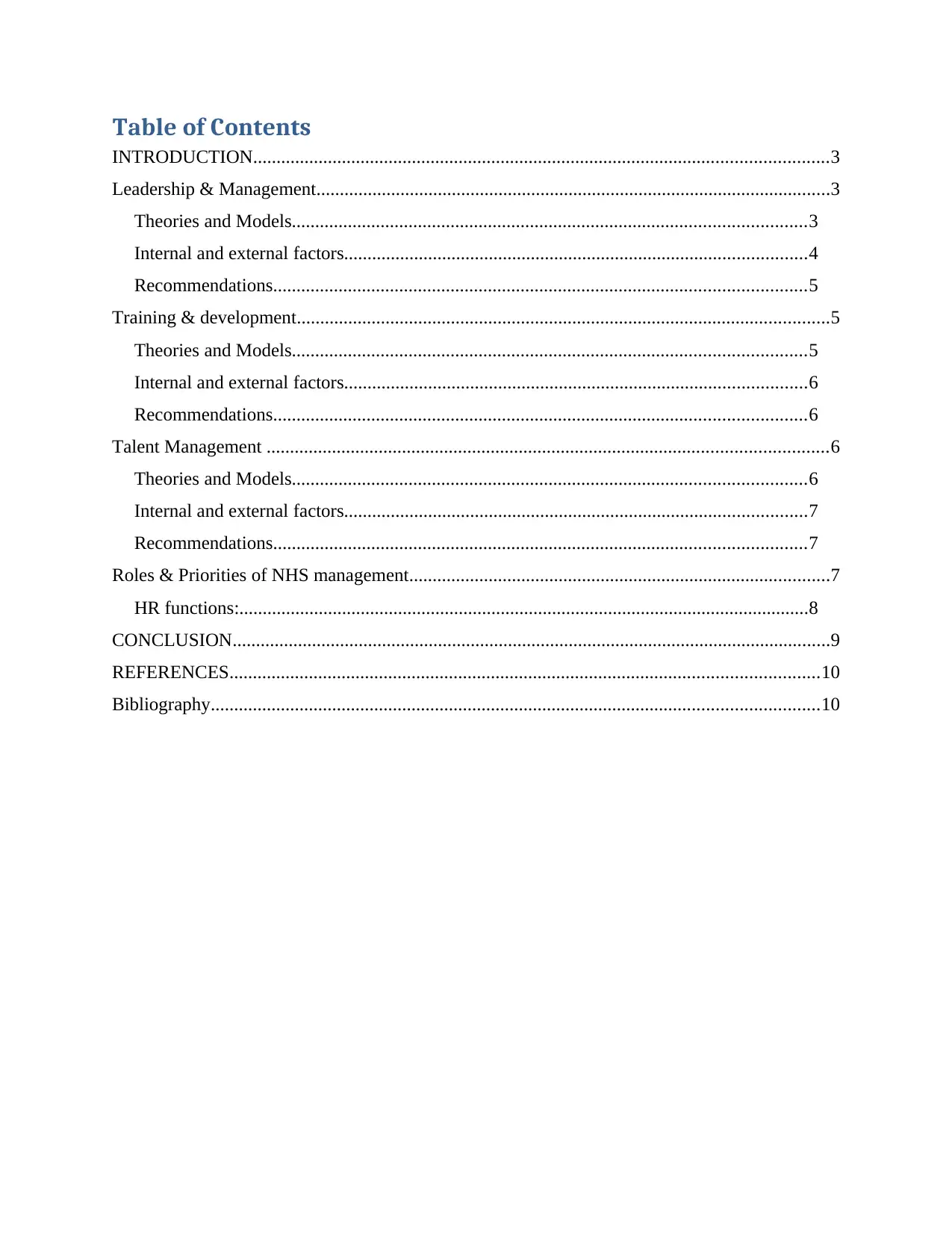
Table of Contents
INTRODUCTION...........................................................................................................................3
Leadership & Management..............................................................................................................3
Theories and Models..............................................................................................................3
Internal and external factors...................................................................................................4
Recommendations..................................................................................................................5
Training & development..................................................................................................................5
Theories and Models..............................................................................................................5
Internal and external factors...................................................................................................6
Recommendations..................................................................................................................6
Talent Management ........................................................................................................................6
Theories and Models..............................................................................................................6
Internal and external factors...................................................................................................7
Recommendations..................................................................................................................7
Roles & Priorities of NHS management..........................................................................................7
HR functions:..........................................................................................................................8
CONCLUSION................................................................................................................................9
REFERENCES..............................................................................................................................10
Bibliography..................................................................................................................................10
INTRODUCTION...........................................................................................................................3
Leadership & Management..............................................................................................................3
Theories and Models..............................................................................................................3
Internal and external factors...................................................................................................4
Recommendations..................................................................................................................5
Training & development..................................................................................................................5
Theories and Models..............................................................................................................5
Internal and external factors...................................................................................................6
Recommendations..................................................................................................................6
Talent Management ........................................................................................................................6
Theories and Models..............................................................................................................6
Internal and external factors...................................................................................................7
Recommendations..................................................................................................................7
Roles & Priorities of NHS management..........................................................................................7
HR functions:..........................................................................................................................8
CONCLUSION................................................................................................................................9
REFERENCES..............................................................................................................................10
Bibliography..................................................................................................................................10
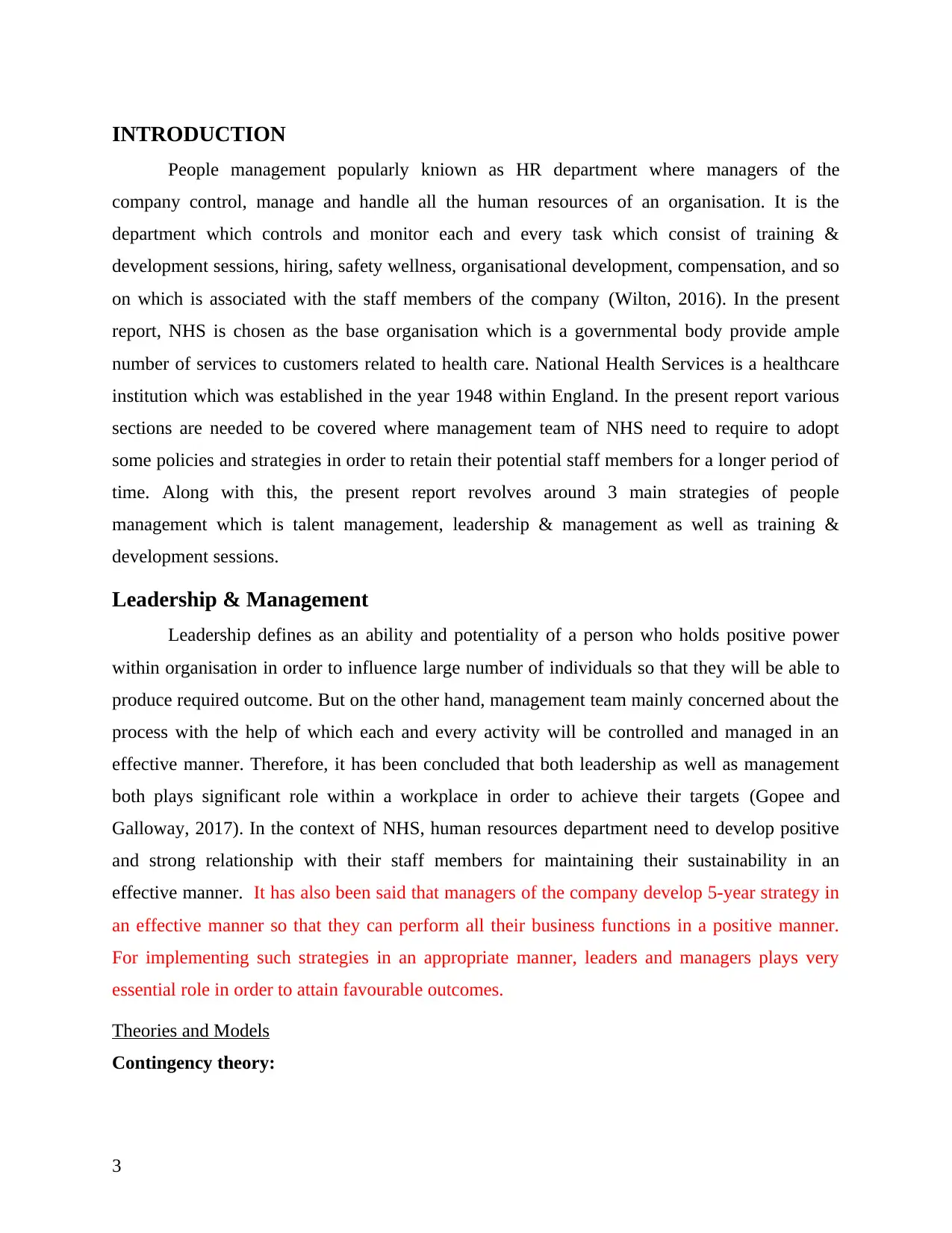
INTRODUCTION
People management popularly kniown as HR department where managers of the
company control, manage and handle all the human resources of an organisation. It is the
department which controls and monitor each and every task which consist of training &
development sessions, hiring, safety wellness, organisational development, compensation, and so
on which is associated with the staff members of the company (Wilton, 2016). In the present
report, NHS is chosen as the base organisation which is a governmental body provide ample
number of services to customers related to health care. National Health Services is a healthcare
institution which was established in the year 1948 within England. In the present report various
sections are needed to be covered where management team of NHS need to require to adopt
some policies and strategies in order to retain their potential staff members for a longer period of
time. Along with this, the present report revolves around 3 main strategies of people
management which is talent management, leadership & management as well as training &
development sessions.
Leadership & Management
Leadership defines as an ability and potentiality of a person who holds positive power
within organisation in order to influence large number of individuals so that they will be able to
produce required outcome. But on the other hand, management team mainly concerned about the
process with the help of which each and every activity will be controlled and managed in an
effective manner. Therefore, it has been concluded that both leadership as well as management
both plays significant role within a workplace in order to achieve their targets (Gopee and
Galloway, 2017). In the context of NHS, human resources department need to develop positive
and strong relationship with their staff members for maintaining their sustainability in an
effective manner. It has also been said that managers of the company develop 5-year strategy in
an effective manner so that they can perform all their business functions in a positive manner.
For implementing such strategies in an appropriate manner, leaders and managers plays very
essential role in order to attain favourable outcomes.
Theories and Models
Contingency theory:
3
People management popularly kniown as HR department where managers of the
company control, manage and handle all the human resources of an organisation. It is the
department which controls and monitor each and every task which consist of training &
development sessions, hiring, safety wellness, organisational development, compensation, and so
on which is associated with the staff members of the company (Wilton, 2016). In the present
report, NHS is chosen as the base organisation which is a governmental body provide ample
number of services to customers related to health care. National Health Services is a healthcare
institution which was established in the year 1948 within England. In the present report various
sections are needed to be covered where management team of NHS need to require to adopt
some policies and strategies in order to retain their potential staff members for a longer period of
time. Along with this, the present report revolves around 3 main strategies of people
management which is talent management, leadership & management as well as training &
development sessions.
Leadership & Management
Leadership defines as an ability and potentiality of a person who holds positive power
within organisation in order to influence large number of individuals so that they will be able to
produce required outcome. But on the other hand, management team mainly concerned about the
process with the help of which each and every activity will be controlled and managed in an
effective manner. Therefore, it has been concluded that both leadership as well as management
both plays significant role within a workplace in order to achieve their targets (Gopee and
Galloway, 2017). In the context of NHS, human resources department need to develop positive
and strong relationship with their staff members for maintaining their sustainability in an
effective manner. It has also been said that managers of the company develop 5-year strategy in
an effective manner so that they can perform all their business functions in a positive manner.
For implementing such strategies in an appropriate manner, leaders and managers plays very
essential role in order to attain favourable outcomes.
Theories and Models
Contingency theory:
3
⊘ This is a preview!⊘
Do you want full access?
Subscribe today to unlock all pages.

Trusted by 1+ million students worldwide
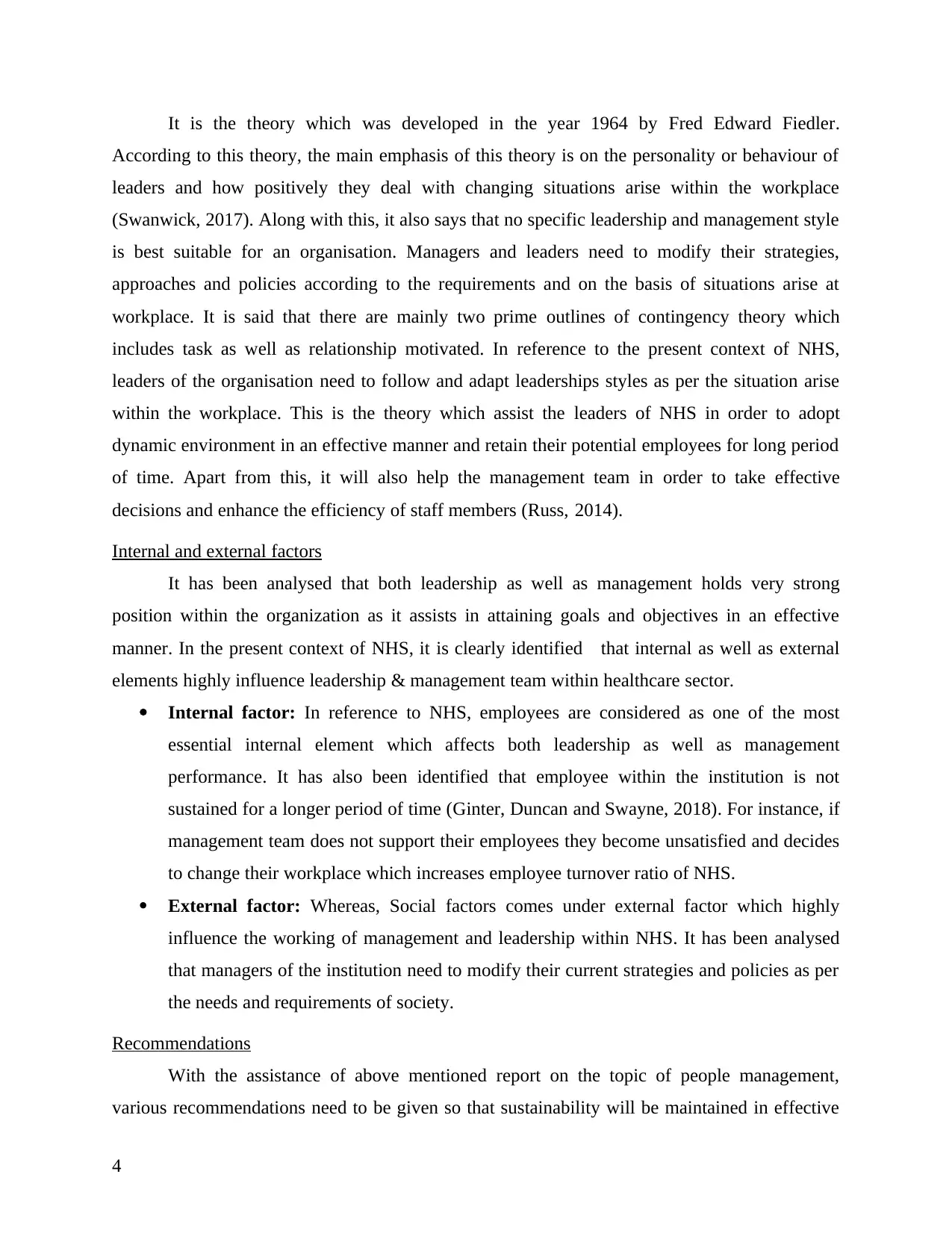
It is the theory which was developed in the year 1964 by Fred Edward Fiedler.
According to this theory, the main emphasis of this theory is on the personality or behaviour of
leaders and how positively they deal with changing situations arise within the workplace
(Swanwick, 2017). Along with this, it also says that no specific leadership and management style
is best suitable for an organisation. Managers and leaders need to modify their strategies,
approaches and policies according to the requirements and on the basis of situations arise at
workplace. It is said that there are mainly two prime outlines of contingency theory which
includes task as well as relationship motivated. In reference to the present context of NHS,
leaders of the organisation need to follow and adapt leaderships styles as per the situation arise
within the workplace. This is the theory which assist the leaders of NHS in order to adopt
dynamic environment in an effective manner and retain their potential employees for long period
of time. Apart from this, it will also help the management team in order to take effective
decisions and enhance the efficiency of staff members (Russ, 2014).
Internal and external factors
It has been analysed that both leadership as well as management holds very strong
position within the organization as it assists in attaining goals and objectives in an effective
manner. In the present context of NHS, it is clearly identified that internal as well as external
elements highly influence leadership & management team within healthcare sector.
Internal factor: In reference to NHS, employees are considered as one of the most
essential internal element which affects both leadership as well as management
performance. It has also been identified that employee within the institution is not
sustained for a longer period of time (Ginter, Duncan and Swayne, 2018). For instance, if
management team does not support their employees they become unsatisfied and decides
to change their workplace which increases employee turnover ratio of NHS.
External factor: Whereas, Social factors comes under external factor which highly
influence the working of management and leadership within NHS. It has been analysed
that managers of the institution need to modify their current strategies and policies as per
the needs and requirements of society.
Recommendations
With the assistance of above mentioned report on the topic of people management,
various recommendations need to be given so that sustainability will be maintained in effective
4
According to this theory, the main emphasis of this theory is on the personality or behaviour of
leaders and how positively they deal with changing situations arise within the workplace
(Swanwick, 2017). Along with this, it also says that no specific leadership and management style
is best suitable for an organisation. Managers and leaders need to modify their strategies,
approaches and policies according to the requirements and on the basis of situations arise at
workplace. It is said that there are mainly two prime outlines of contingency theory which
includes task as well as relationship motivated. In reference to the present context of NHS,
leaders of the organisation need to follow and adapt leaderships styles as per the situation arise
within the workplace. This is the theory which assist the leaders of NHS in order to adopt
dynamic environment in an effective manner and retain their potential employees for long period
of time. Apart from this, it will also help the management team in order to take effective
decisions and enhance the efficiency of staff members (Russ, 2014).
Internal and external factors
It has been analysed that both leadership as well as management holds very strong
position within the organization as it assists in attaining goals and objectives in an effective
manner. In the present context of NHS, it is clearly identified that internal as well as external
elements highly influence leadership & management team within healthcare sector.
Internal factor: In reference to NHS, employees are considered as one of the most
essential internal element which affects both leadership as well as management
performance. It has also been identified that employee within the institution is not
sustained for a longer period of time (Ginter, Duncan and Swayne, 2018). For instance, if
management team does not support their employees they become unsatisfied and decides
to change their workplace which increases employee turnover ratio of NHS.
External factor: Whereas, Social factors comes under external factor which highly
influence the working of management and leadership within NHS. It has been analysed
that managers of the institution need to modify their current strategies and policies as per
the needs and requirements of society.
Recommendations
With the assistance of above mentioned report on the topic of people management,
various recommendations need to be given so that sustainability will be maintained in effective
4
Paraphrase This Document
Need a fresh take? Get an instant paraphrase of this document with our AI Paraphraser

manner. It has been said that NHS required to adopt different strategies and policies with the
help of which they can improve their operations. There are some suggestions made to the
management team of the institution in order to reduce the current manpower issues and
problems. These are the recommendations provided on the basis of three main areas, which are
going to be discussed as follows:
First area in this report is leadership & management and for this it has been
recommended to the top management team of NHS that they should adopt contingency style of
leadership. Reason behind this is that it assists in controlling and managing all types of situations
in an effective manner arise within NHS.
Training & development
It defines as the procedure of enhancing and improving the capability and skills of staff
members working at the business entity so that their performance will be increased and assist in
attaining goals and objectives. In the present context of NHS case study, it has been said that
company is required to hire 6000 nurses for performing their business functions in an effective
manner. For this, training & development session is required by the management team to
enhance their efficiencies and effectiveness (Marx, Strauss and Williamson, 2015).
Theories and Models
Transitional Model: It refers to the model which highly focusses on the whole
organisation. It has been identified that this is the theory which is based on two main loops.
Outer loop is the one which consists of mission, value and vision of the organization but on the
other hand in case of inner loop where every activity is executed (Clyne and Paul George, 2015).
According to transitional model, managers and leader need to develop training and development
session so that new technologies will be adopted by the staff members in an appropriate manner.
In the present context of NHS, while managers develop their training & development sessions it
is very essential to examine all the factors so that they will be able to gain competitive
advantages. Manager of the company develop strategies about training and development sessions
to enhance the efficiency of staff members whereas leaders of the company implement all these
strategies in a positive manner so that they gain favourable results.
5
help of which they can improve their operations. There are some suggestions made to the
management team of the institution in order to reduce the current manpower issues and
problems. These are the recommendations provided on the basis of three main areas, which are
going to be discussed as follows:
First area in this report is leadership & management and for this it has been
recommended to the top management team of NHS that they should adopt contingency style of
leadership. Reason behind this is that it assists in controlling and managing all types of situations
in an effective manner arise within NHS.
Training & development
It defines as the procedure of enhancing and improving the capability and skills of staff
members working at the business entity so that their performance will be increased and assist in
attaining goals and objectives. In the present context of NHS case study, it has been said that
company is required to hire 6000 nurses for performing their business functions in an effective
manner. For this, training & development session is required by the management team to
enhance their efficiencies and effectiveness (Marx, Strauss and Williamson, 2015).
Theories and Models
Transitional Model: It refers to the model which highly focusses on the whole
organisation. It has been identified that this is the theory which is based on two main loops.
Outer loop is the one which consists of mission, value and vision of the organization but on the
other hand in case of inner loop where every activity is executed (Clyne and Paul George, 2015).
According to transitional model, managers and leader need to develop training and development
session so that new technologies will be adopted by the staff members in an appropriate manner.
In the present context of NHS, while managers develop their training & development sessions it
is very essential to examine all the factors so that they will be able to gain competitive
advantages. Manager of the company develop strategies about training and development sessions
to enhance the efficiency of staff members whereas leaders of the company implement all these
strategies in a positive manner so that they gain favourable results.
5
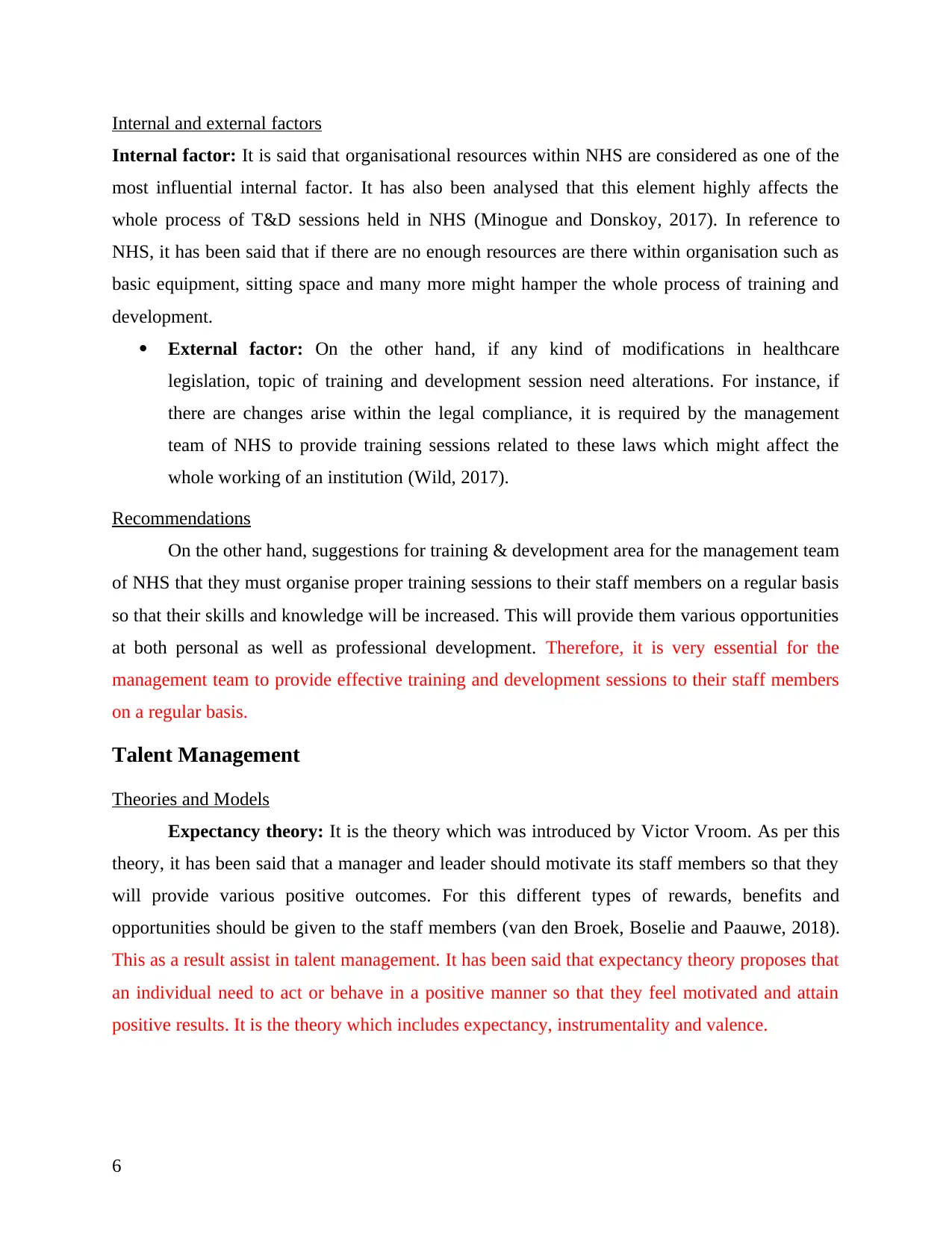
Internal and external factors
Internal factor: It is said that organisational resources within NHS are considered as one of the
most influential internal factor. It has also been analysed that this element highly affects the
whole process of T&D sessions held in NHS (Minogue and Donskoy, 2017). In reference to
NHS, it has been said that if there are no enough resources are there within organisation such as
basic equipment, sitting space and many more might hamper the whole process of training and
development.
External factor: On the other hand, if any kind of modifications in healthcare
legislation, topic of training and development session need alterations. For instance, if
there are changes arise within the legal compliance, it is required by the management
team of NHS to provide training sessions related to these laws which might affect the
whole working of an institution (Wild, 2017).
Recommendations
On the other hand, suggestions for training & development area for the management team
of NHS that they must organise proper training sessions to their staff members on a regular basis
so that their skills and knowledge will be increased. This will provide them various opportunities
at both personal as well as professional development. Therefore, it is very essential for the
management team to provide effective training and development sessions to their staff members
on a regular basis.
Talent Management
Theories and Models
Expectancy theory: It is the theory which was introduced by Victor Vroom. As per this
theory, it has been said that a manager and leader should motivate its staff members so that they
will provide various positive outcomes. For this different types of rewards, benefits and
opportunities should be given to the staff members (van den Broek, Boselie and Paauwe, 2018).
This as a result assist in talent management. It has been said that expectancy theory proposes that
an individual need to act or behave in a positive manner so that they feel motivated and attain
positive results. It is the theory which includes expectancy, instrumentality and valence.
6
Internal factor: It is said that organisational resources within NHS are considered as one of the
most influential internal factor. It has also been analysed that this element highly affects the
whole process of T&D sessions held in NHS (Minogue and Donskoy, 2017). In reference to
NHS, it has been said that if there are no enough resources are there within organisation such as
basic equipment, sitting space and many more might hamper the whole process of training and
development.
External factor: On the other hand, if any kind of modifications in healthcare
legislation, topic of training and development session need alterations. For instance, if
there are changes arise within the legal compliance, it is required by the management
team of NHS to provide training sessions related to these laws which might affect the
whole working of an institution (Wild, 2017).
Recommendations
On the other hand, suggestions for training & development area for the management team
of NHS that they must organise proper training sessions to their staff members on a regular basis
so that their skills and knowledge will be increased. This will provide them various opportunities
at both personal as well as professional development. Therefore, it is very essential for the
management team to provide effective training and development sessions to their staff members
on a regular basis.
Talent Management
Theories and Models
Expectancy theory: It is the theory which was introduced by Victor Vroom. As per this
theory, it has been said that a manager and leader should motivate its staff members so that they
will provide various positive outcomes. For this different types of rewards, benefits and
opportunities should be given to the staff members (van den Broek, Boselie and Paauwe, 2018).
This as a result assist in talent management. It has been said that expectancy theory proposes that
an individual need to act or behave in a positive manner so that they feel motivated and attain
positive results. It is the theory which includes expectancy, instrumentality and valence.
6
⊘ This is a preview!⊘
Do you want full access?
Subscribe today to unlock all pages.

Trusted by 1+ million students worldwide
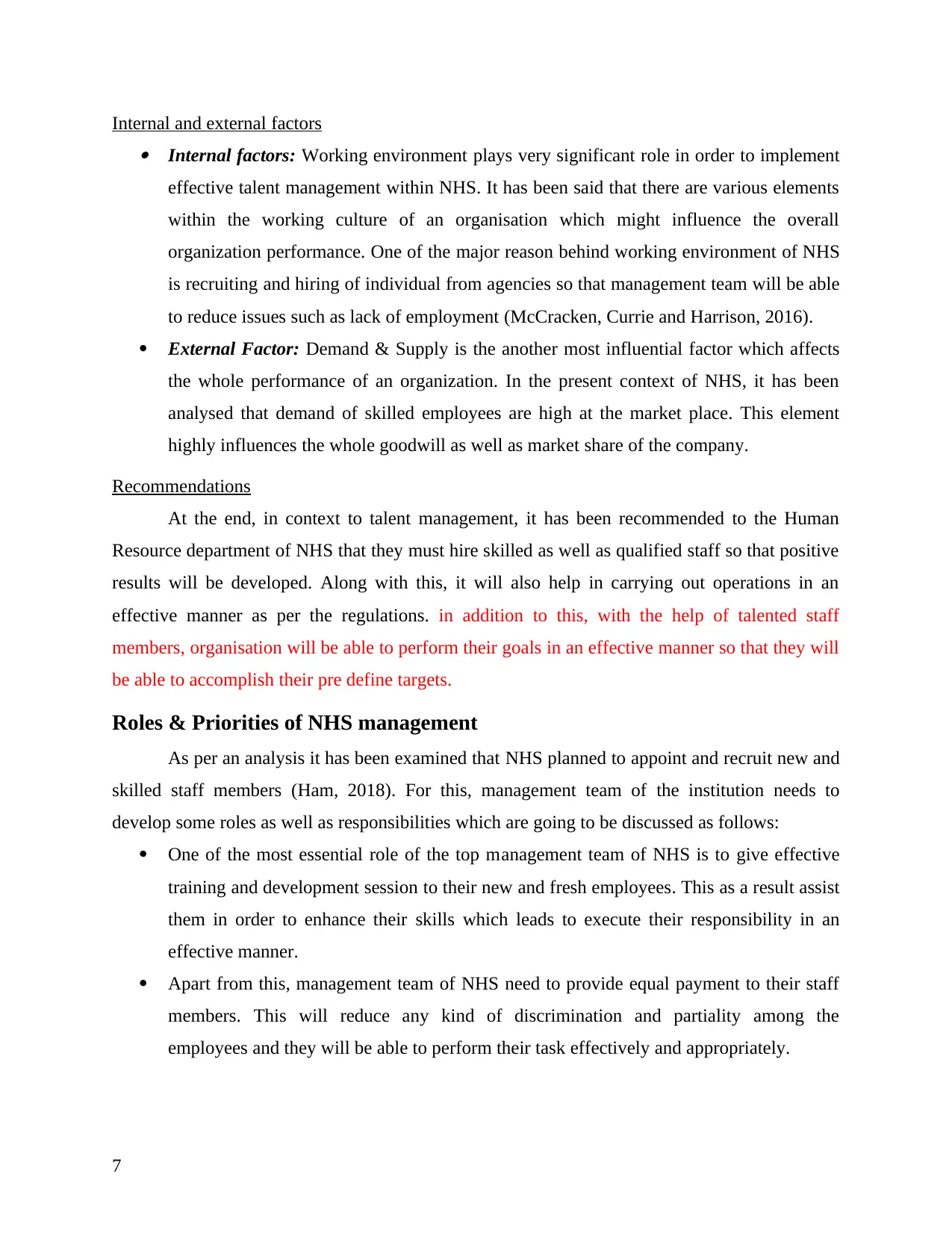
Internal and external factors Internal factors: Working environment plays very significant role in order to implement
effective talent management within NHS. It has been said that there are various elements
within the working culture of an organisation which might influence the overall
organization performance. One of the major reason behind working environment of NHS
is recruiting and hiring of individual from agencies so that management team will be able
to reduce issues such as lack of employment (McCracken, Currie and Harrison, 2016).
External Factor: Demand & Supply is the another most influential factor which affects
the whole performance of an organization. In the present context of NHS, it has been
analysed that demand of skilled employees are high at the market place. This element
highly influences the whole goodwill as well as market share of the company.
Recommendations
At the end, in context to talent management, it has been recommended to the Human
Resource department of NHS that they must hire skilled as well as qualified staff so that positive
results will be developed. Along with this, it will also help in carrying out operations in an
effective manner as per the regulations. in addition to this, with the help of talented staff
members, organisation will be able to perform their goals in an effective manner so that they will
be able to accomplish their pre define targets.
Roles & Priorities of NHS management
As per an analysis it has been examined that NHS planned to appoint and recruit new and
skilled staff members (Ham, 2018). For this, management team of the institution needs to
develop some roles as well as responsibilities which are going to be discussed as follows:
One of the most essential role of the top management team of NHS is to give effective
training and development session to their new and fresh employees. This as a result assist
them in order to enhance their skills which leads to execute their responsibility in an
effective manner.
Apart from this, management team of NHS need to provide equal payment to their staff
members. This will reduce any kind of discrimination and partiality among the
employees and they will be able to perform their task effectively and appropriately.
7
effective talent management within NHS. It has been said that there are various elements
within the working culture of an organisation which might influence the overall
organization performance. One of the major reason behind working environment of NHS
is recruiting and hiring of individual from agencies so that management team will be able
to reduce issues such as lack of employment (McCracken, Currie and Harrison, 2016).
External Factor: Demand & Supply is the another most influential factor which affects
the whole performance of an organization. In the present context of NHS, it has been
analysed that demand of skilled employees are high at the market place. This element
highly influences the whole goodwill as well as market share of the company.
Recommendations
At the end, in context to talent management, it has been recommended to the Human
Resource department of NHS that they must hire skilled as well as qualified staff so that positive
results will be developed. Along with this, it will also help in carrying out operations in an
effective manner as per the regulations. in addition to this, with the help of talented staff
members, organisation will be able to perform their goals in an effective manner so that they will
be able to accomplish their pre define targets.
Roles & Priorities of NHS management
As per an analysis it has been examined that NHS planned to appoint and recruit new and
skilled staff members (Ham, 2018). For this, management team of the institution needs to
develop some roles as well as responsibilities which are going to be discussed as follows:
One of the most essential role of the top management team of NHS is to give effective
training and development session to their new and fresh employees. This as a result assist
them in order to enhance their skills which leads to execute their responsibility in an
effective manner.
Apart from this, management team of NHS need to provide equal payment to their staff
members. This will reduce any kind of discrimination and partiality among the
employees and they will be able to perform their task effectively and appropriately.
7
Paraphrase This Document
Need a fresh take? Get an instant paraphrase of this document with our AI Paraphraser

HR functions: Recruitment: First and the foremost function of Human resource is to recruit potential
and right candidate who is highly skilled and capable to perform all the assigned task
effectively within NHS. Role of a recruitment function is to hire required human resource
within the workplace so that each and every activity will be performed effectively (Rees
and Smith, 2017). Training & development: The another HR function assist in providing training and
development session to the workplace so that their skills will be improved. In the present
context of NHS, human resource management conduct such sessions on a regular basis so
that skills, knowledge and capabilities will be improved which leads to higher
productivity in the workplace (Bratton, 2018). Apart from this, training should be
provided to the nurses how to use new equipment’s so that any type of infection will be
avoided while treating patient.
Employee relations: This is the most significant HR function in order to develop positive
and strong relationship among employer & employees. In the present context of NHS
managers conduct improvement hub where medical staff member shares their views,
thought and experiences which each other. Major role of employee relation function is to
improve the relationship between employee and employer.
On the basis of above stated HR functions as well as roles & priorities of top
management team of NHS it can easily be said that all this help in maintaining growth of the
company at the marketplace.
CONCLUSION
On the basis of above mentioned report, it has been identified that people management is
one of the most significant element within the workplace. Along with this, there must be proper
use of leadership and management styles so that positive results will be developed effectively.
Furthermore, by providing regular training and development session to their staff members
managers will be able to enhance their performance and effectiveness.
8
and right candidate who is highly skilled and capable to perform all the assigned task
effectively within NHS. Role of a recruitment function is to hire required human resource
within the workplace so that each and every activity will be performed effectively (Rees
and Smith, 2017). Training & development: The another HR function assist in providing training and
development session to the workplace so that their skills will be improved. In the present
context of NHS, human resource management conduct such sessions on a regular basis so
that skills, knowledge and capabilities will be improved which leads to higher
productivity in the workplace (Bratton, 2018). Apart from this, training should be
provided to the nurses how to use new equipment’s so that any type of infection will be
avoided while treating patient.
Employee relations: This is the most significant HR function in order to develop positive
and strong relationship among employer & employees. In the present context of NHS
managers conduct improvement hub where medical staff member shares their views,
thought and experiences which each other. Major role of employee relation function is to
improve the relationship between employee and employer.
On the basis of above stated HR functions as well as roles & priorities of top
management team of NHS it can easily be said that all this help in maintaining growth of the
company at the marketplace.
CONCLUSION
On the basis of above mentioned report, it has been identified that people management is
one of the most significant element within the workplace. Along with this, there must be proper
use of leadership and management styles so that positive results will be developed effectively.
Furthermore, by providing regular training and development session to their staff members
managers will be able to enhance their performance and effectiveness.
8

REFERENCES
Books and Journals
Wilton, N., 2016. An introduction to human resource management. Sage.
Gopee, N. and Galloway, J., 2017. Leadership and management in healthcare. Sage.
Swanwick, T., 2017. Leadership theories and concepts. ABC of clinical leadership E, 2, pp.9-13.
Ginter, P. M., Duncan, W. J. and Swayne, L. E., 2018. The strategic management of health care
organizations.
John Wiley & Sons.Marx, R., Strauss, C. and Williamson, C., 2015. Mindfulness apprenticeship:
a new model of NHS-based MBCT teacher training. Mindfulness, 6(2), pp.253-263.
Clyne, B. and Paul George MD, M.P.H.E., 2015. Leadership in undergraduate medical
education: training future physician leaders. Rhode Island Medical Journal, 98(9), p.36.
Minogue, V. and Donskoy, A. L., 2017. Developing a training package. International journal of
health care quality assurance.
van den Broek, J., Boselie, P. and Paauwe, J., 2018. Cooperative innovation through a talent
management pool: A qualitative study on coopetition in healthcare. European
Management Journal, 36(1), pp.135-144.
McCracken, M., Currie, D. and Harrison, J., 2016. Understanding graduate recruitment,
development and retention for the enhancement of talent management: sharpening ‘the
edge’of graduate talent. The International Journal of Human Resource
Management, 27(22), pp.2727-2752.
Ham, C., 2018. Management and Competition in the NHS. CRC Press.Rees, G. and Smith, P.
eds., 2017. Strategic human resource management: An international perspective. Sage.
Bratton, A., 2018. The role of talent development in environmentally sustainable
hospitality. Worldwide Hospitality and Tourism Themes.
Bibliography
Malik, A. and Rowley, C., 2015. 1 Profiting from people management practices: an introduction.
In Business Models and People Management in the Indian IT Industry (pp. 21-32).
Routledge.
Michie, J., Sparrow, P., Cooper, C. and Hird, M., 2016. Do we need HR?: Repositioning people
management for success. Springer.
Nevins, J. and Peluso, N.L. eds., 2018. Taking Southeast Asia to market: Commodities, nature,
and people in the neoliberal age. Cornell University Press.
Tapping, D. and Shuker, T., 2018. Value Stream Management for the Lean Office: Eight Steps to
Planning, Mapping, & Sustaining Lean Improvements in Administrative Areas.
Productivity Press.
Taylor, T., Doherty, A. and McGraw, P., 2015. Managing people in sport organizations: A
strategic human resource management perspective. Routledge.
9
Books and Journals
Wilton, N., 2016. An introduction to human resource management. Sage.
Gopee, N. and Galloway, J., 2017. Leadership and management in healthcare. Sage.
Swanwick, T., 2017. Leadership theories and concepts. ABC of clinical leadership E, 2, pp.9-13.
Ginter, P. M., Duncan, W. J. and Swayne, L. E., 2018. The strategic management of health care
organizations.
John Wiley & Sons.Marx, R., Strauss, C. and Williamson, C., 2015. Mindfulness apprenticeship:
a new model of NHS-based MBCT teacher training. Mindfulness, 6(2), pp.253-263.
Clyne, B. and Paul George MD, M.P.H.E., 2015. Leadership in undergraduate medical
education: training future physician leaders. Rhode Island Medical Journal, 98(9), p.36.
Minogue, V. and Donskoy, A. L., 2017. Developing a training package. International journal of
health care quality assurance.
van den Broek, J., Boselie, P. and Paauwe, J., 2018. Cooperative innovation through a talent
management pool: A qualitative study on coopetition in healthcare. European
Management Journal, 36(1), pp.135-144.
McCracken, M., Currie, D. and Harrison, J., 2016. Understanding graduate recruitment,
development and retention for the enhancement of talent management: sharpening ‘the
edge’of graduate talent. The International Journal of Human Resource
Management, 27(22), pp.2727-2752.
Ham, C., 2018. Management and Competition in the NHS. CRC Press.Rees, G. and Smith, P.
eds., 2017. Strategic human resource management: An international perspective. Sage.
Bratton, A., 2018. The role of talent development in environmentally sustainable
hospitality. Worldwide Hospitality and Tourism Themes.
Bibliography
Malik, A. and Rowley, C., 2015. 1 Profiting from people management practices: an introduction.
In Business Models and People Management in the Indian IT Industry (pp. 21-32).
Routledge.
Michie, J., Sparrow, P., Cooper, C. and Hird, M., 2016. Do we need HR?: Repositioning people
management for success. Springer.
Nevins, J. and Peluso, N.L. eds., 2018. Taking Southeast Asia to market: Commodities, nature,
and people in the neoliberal age. Cornell University Press.
Tapping, D. and Shuker, T., 2018. Value Stream Management for the Lean Office: Eight Steps to
Planning, Mapping, & Sustaining Lean Improvements in Administrative Areas.
Productivity Press.
Taylor, T., Doherty, A. and McGraw, P., 2015. Managing people in sport organizations: A
strategic human resource management perspective. Routledge.
9
⊘ This is a preview!⊘
Do you want full access?
Subscribe today to unlock all pages.

Trusted by 1+ million students worldwide

10
Paraphrase This Document
Need a fresh take? Get an instant paraphrase of this document with our AI Paraphraser

11
1 out of 11
Related Documents
Your All-in-One AI-Powered Toolkit for Academic Success.
+13062052269
info@desklib.com
Available 24*7 on WhatsApp / Email
![[object Object]](/_next/static/media/star-bottom.7253800d.svg)
Unlock your academic potential
Copyright © 2020–2025 A2Z Services. All Rights Reserved. Developed and managed by ZUCOL.





